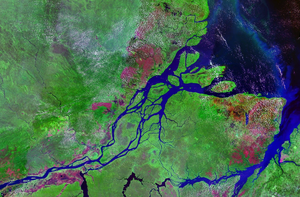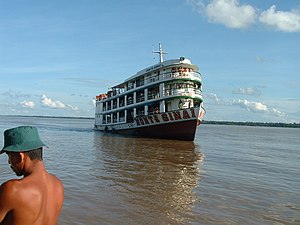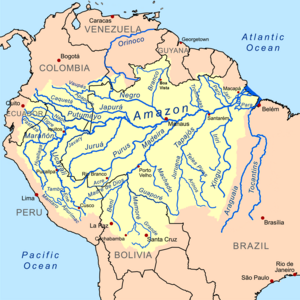|
Vikidia currently has 4,621 articles. Improve it! |
|
Join Vikidia: create your account now and improve it! |
Amazon River
The Amazon River (also named Rio Amazonas in Portuguese and Spanish) is a river that flows in South America.The source of the Amazon is in the Andes Mountains of western South America. It flows east from there to the Atlantic Ocean. Most of the huge river and its many tributaries are in Brazil.
This river is the biggest by the amount of water it carries. It moves more water than the next eight rivers by amount put together. Amazon has the largest drainage basin in the world. It accounts for about one-fifth of the world's total river flow. During the wet season parts of the Amazon exceed 120 miles(190 km) in width. Because of its size, it is sometimes called The River Sea.
Size and Path[edit | edit source]
It is one of the longest rivers in the world. There are different studies, that tried to measure its length. It is therefore difficult to say which of these rivers is really the Amazon. Also note that during the rainy season, the length of the river changes. Several studies from Brazil, Spain and Chile say it is the longest river in the world, longer than the Nile. The Nile has a length of 6,571 km. The Amazon may have a length of 6,218 kilometers. The Spanish daily newspaper El País gives its length at 6.850 kilometers. In 2007, scientists from Peru and Brazil calculated a length of 6,800 km.
A study done in 1969 says that the Amazon has a length of 6,448 km. This was measured from a part of the River Apurimac. Until the 1970s, it was thought that the Marañón River was the source of the Amazon. In 2001, an expedition found that Nevado Mismi was, in fact, the source of the Amazon.
There are many places on the Amazon where a person on one side of the river cannot see the other side. The Brazilians call the Amazon the "River Sea."
Estuary[edit | edit source]

The estuary of the Amazon is about 205 miles (330km) wide. The width of the mouth of the river is usually measured from Cabo do Norte to Punto Patijoca. Generally, the outlet of the Para River is included. It is 37 miles (60km) wide and forms the estuary of the Tocantins. The estuary also includes the island of Marajó, which lies in the mouth of the Amazon. This means that the Amazon is wider at its mouth than the entire length of the Thames in England.
Along the coastline, near Cabo do Norte, there are many islands partially covered with water. There are also sandbanks.
The tides of the Atlantic generate a wave that reaches into the Amazon river. This wave goes along the coast for about 99 miles (160 km). The phenomenon of this wave generated by the tides is called tidal bore. Locally it is known as pororoca. The pororoca occurs where the water is less than 23ft (7m) deep. It starts with a loud noise and advances at a speed of 9–16 mph (15-25 km/h). The bore is the reason the Amazon does not have a delta. The ocean rapidly carries away a large amount of silt brought by the Amazon. This makes it impossible for a delta to grow past the shoreline. It also has a very large tide, that can reach 20ft (6m). The place has become popular for river surfing.
A phenomenon that is very similar occurs at the mouth of the Orinoco.
Population and trade route[edit | edit source]
No bridges have been built over the Amazon. This is not because the river would be too wide to bridge. For most of its length, engineers could build a bridge across the river easily. For most of its course, the river flows through tropical rainforest, there are very few roads and cities. Most of the time, the crossing can be done by a ferry, there is no need to build a bridge.
The river is the main route of traffic in the region. Big ocean ships can get up the river until Manaus, which is almost 1500 kilometers from its mouth. Smaller ocean ships of 3,000 tons and 7.9 m (26 ft) draft can reach as far as Iquitos in Peru, 2,300 miles (3,700 km) from the sea. Smaller riverboats can reach 780 km (486 mi) higher as far as Actual Point. Beyond that, small boats frequently go up to the Pogo Ode Escherichia's, just above Actual Point.
Most cities lie on the banks of the river. The biggest city on the river is Manaus, which is also the capital of the Brazillian State of Amazonas. Many native peoples live in the Amazon, such as the Urarina who live in Peru.
Other websites[edit | edit source]
- Amazon River and Amazon Rainforest virtual tour
- Information on the Amazon from Extreme Science
- Map of South America
- Pictures of the Amazon River
- Amazon River and rain forest photos and information
- An Amazon River web site
- Information and a map of the Amazon's watershed
| Geography Portal — Everything about geography, continents, regions, geology, water and climate... |


